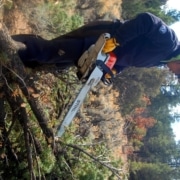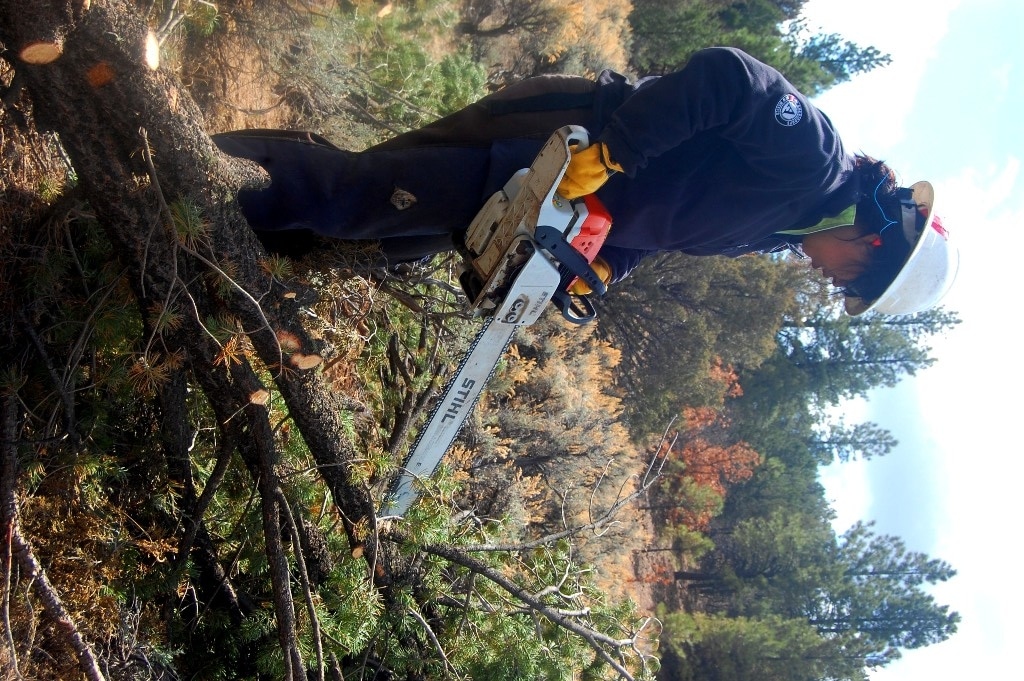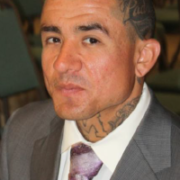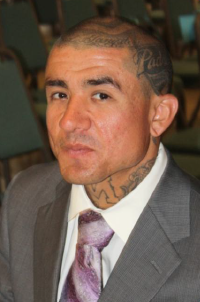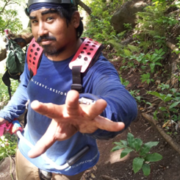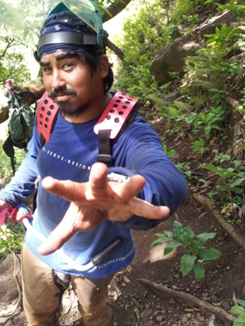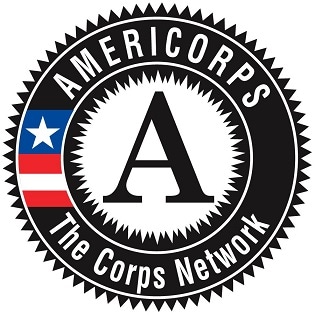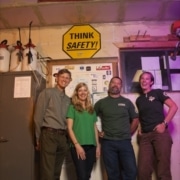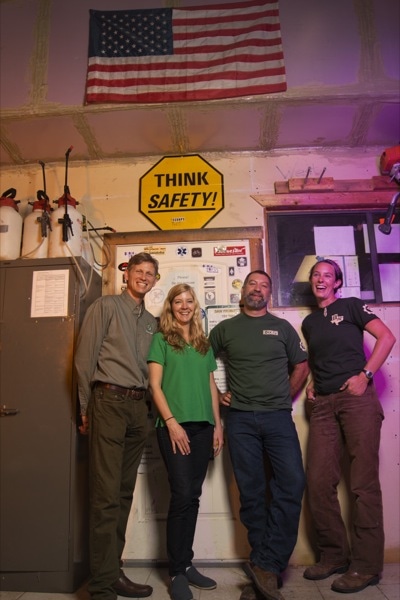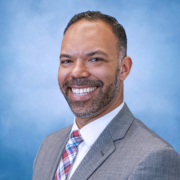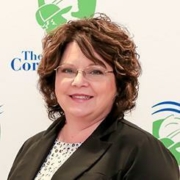Here is the full conversation with Megan Helton, Texas Conservation Corps emergency response team field coordinator; Parc Smith, American YouthWorks CEO; Rachel Matvy, American YouthWorks communications coordinator; and Chris Sheffield, Texas Conservation Corps program director.
Austin Chronicle: How did Texas Conservation Corps come to be involved with disaster relief in general, and how were you all were deployed to the Bastrop fires?
PS: Bastrop County would have called the state Department of Emergency Management, which then calls FEMA. FEMA contacts the Corporation for National and Community Service(CNCS, which includes AmeriCorps, FEMA Corps, etc.), who then reaches out to local conservation corps, and that’s how they brought us in. We had been already serving in previous disasters like Joplin, Missouri [multiple-vortex tornadoes, Sunday, May 22, 2011], and others before that. They knew we were a resource and very local, so they called on us to come and play a role.
MH: We had an agreement through the CNCS to be able to deploy on a FEMA mission assignment. So that’s how we ended up in Bastrop. Since then, we have more direct lines of communication with the Texas Division of Emergency Management and One Star. It’s direct line: With or without a FEMA declaration, we can get called in and don’t have to wait a week for the declaration.
Austin Chronicle: Take me through the first steps: Did this call come in close to the timeframe of the wildfire? Was it still burning? Were you already on the ground once the request was made, and the order was in?
MH: We arrived in Bastrop on September 7 [three days after the fire ignited]. We were called in because it was a local request through the county, which had very basic infrastructure set up for volunteer and donations management. Luckily we had just been in Joplin, so we were able to expand that infrastructure. We worked with local authorities to establish a volunteer reception center and a donation management center. Because at that time, donations management looked like this: You drive into a parking lot and you kick a bag of clothes into that parking lot; you drive away and hope someone deals with them.
Our first task was to find a location. The pastor of Calvary Baptist had lost his home and opened his doors at his church to us and kept us there for two full months. We had complete run of that church, which was really a blessing. We slept in Bastrop State Park, right across the street from the church. It was still smoldering out there. We had trees coming down at night and hotspots showing up around our bunks. We were in it.
The county did not want volunteers out in the debris field while the fire was still burning. So the word got out to turn away volunteers. But volunteers were needed elsewhere. Our second task was to reverse that media and let people know that volunteers were still needed. We had people pre-register to volunteer, and then help us with the donations. “You got a truck and trailer? Bring it! We’ve got a job for you; come drive around and find and sort all of these donations.”
PS: The day the fires happened, I called Brent Leisure, then State Parks Director. He lived out there and lost his home. But they weren’t ready for us at that point, they were just trying to put flames out. But the county saw that there was a second wave of problems to deal with. There’s a great guy over there, Mike Fisher, who always says ‘When green shirts arrive [TxCC uniform is green T-shirts], they stop the second disaster,’ which was this accumulation of donated goods and wave of volunteers that couldn’t be coordinated yet.
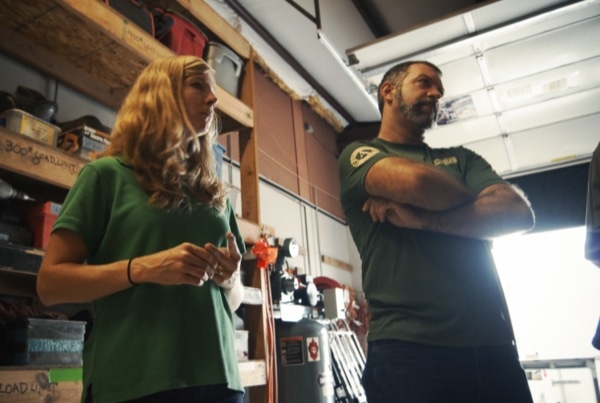
Austin Chronicle: What were some of the early challenges and tasks you faced?
MH: Turning volunteers away can really crush the ability to rebuild. We knew we needed a way for people to be able to learn about volunteer opportunities. Number two, have a registration process, as system for sign up and call back. Number three was going through and figuring out what the volunteer opportunities were. We knew donations needed help, but who else was out there? Who was doing feeding? What’s going on with the shelters? We did a lot of outreach, worked closely with United Methodists, the Mennonites, the Episcopal groups, St. Vincent de Paul, and local churches for volunteer referrals.
Volunteer hours are very important part of the recovery process because they have a monetary value. If you have a FEMA declaration and public assistance is awarded, volunteer hours can reduce the local cost of recovery. In most disasters, FEMA covers 75% and the local jurisdiction has to cover 25% of the costs. Volunteer hours are counted as resources leveraged, so it shows you’ve already spent $21 an hour per volunteer. It just reduces the 25% cost. If you generate $100,000 worth of volunteer hours, you don’t have to pay that $100,000.
We immediately went into outreach mode, tracking volunteer hours, in a formal way.
Bastrop is such a strong community: neighbors were helping neighbors. People who hadn’t lost their homes were spending days helping their neighbors who had. We needed some way to track those hours. So we set up volunteer hour sign-in posts, so people would come in and take a sheet of their own, saying I’m volunteering all weekend to help my neighbor clean up their house. It was really neat. We had people downloading it off a website and coming in showing us their hours they had completed helping one another.
The main focus was the cleanup – what we could do with volunteers? There was official case management going on through St. Vincent de Paul. We had a handful of AmeriCorps members to do database and intake work for homeowner registration assistance requests or work-order process.
There is a triage element to that paperwork: Are you uninsured, elderly, disabled, single-parent household? We coordinate across the different agencies – with whomever else is doing a work order process. It gives you a pretty good jump into long-term recovery, so we were able to use that paperwork and that initial assistance request and turn it over to long-term recovery. It’s separate from, but goes hand-in-hand with case management. It allows you to get a profile on volunteer services on a piece of property from beginning to end. We had 980 people – rentals and homeowners – sign up in the first two months. When I say just us, that was in our database. Our partnering agencies had contributed to that as well.
Austin Chronicle: Parc, how exactly does American YouthWorks factor into this?
PS: American YouthWorks is the parent organization that started this program. It’s grown in the last year or two, changed its name to Texas Conservation Corps, I think at the time we showed up in Bastrop, we were still Environmental Corps. It’s a program of American YouthWorks, like our Casa Verde is a program and our school is a program. When they show up, their name recognition is really Texas Conservation Corps, a program of American YouthWorks. They’re not two separate entities.
Every time a disaster happens, it’s a brand-new situation. They don’t have a bunch of forms ready to go. When Megan and the team showed up, they had just come back from Joplin and brought all this infrastructure and paperwork and knowledge about what needs to happen to make sure the county doesn’t have to pay so much out of pocket. At first the county was just wanting to help people and wouldn’t even slow down to take the intake forms in, but Megan and [crew] said, “Wait, this is worth real dollars to the county.” They brought those forms from the Joplin experience and used them to help the county register all these people.
MH: In an ideal world, when we deploy, we have an experienced local entity set up with a plan for long-term volunteer management. In this case, local entities were set up but quickly realized they were overwhelmed. In this case, we found two women, Kate Johnston and Paige Webb, who had been volunteering every day, taking volunteers into the field, working with homeowners and agencies and had completely integrated into our operation. They wanted to do this for their community. They stood up and they took it on.
Meanwhile, we were looking at holidays, and our season was over. We couldn’t be out there anymore. Bastrop’s a great community, but Kate and Paige didn’t have an organization behind them yet. They were just two individuals. So we left them with the database and called in an AmeriCorps NCCC team to give them physical support, and they pushed through the year until January. Mike Fisher with the county was supportive of the entire volunteer operation from beginning to end. He helped with the NCCC team, helping keep them engaged and supporting Kate and Paige as best as possible. Two years later, they’re able to go around and train other communities on setting up long-term recovery, which is phenomenal.
Austin Chronicle: How do federal and state funding, and how does the insurance scenario play into what you do?
PS: My first thought on this is that we’re almost not interested in that. We bring motivated young people to the table who can’t wait to help others and be of value and worth. There’s a need, that part is clear, regardless of what a person’s insurance is or how much forethought they put into things: They need help today. Our role is to provide that help and structure and bring some systems to place that bring sanity to an insane situation. We don’t even think about [the funding] because we’re so logistics-focused at the time. I’m sure there are late-night conversations about this around the campfire after the day’s work, but that part doesn’t touch us. The insurance companies have nothing to do with us. Some people may reflect about how well FEMA – or the government response – works or doesn’t work. But we wouldn’t be there without that FEMA and the CNCS and state support. All those government entities are there to bring us to bear on this, whether people think it’s perfect or not, it is a system that’s present. It allows us to come in and provide needed services.
We’re not funded by good will. We have to be working on projects, we have to pay young people to work, we have to pay for vehicles and gas and paper and tents and all the things it takes to show up and be of value where we’re needed. That infrastructure of the counties, state, and feds working together to bring in the muscle and brains of the young people to play a role that is very helpful. In big bureaucracies, there are always kinks that have to be ironed out, but imagine the scenarios without it – clothes dropped in parking lots, people wondering who’s in charge. Our participation in these systems gives us an understanding of the incident, command structure, and chain-of-command communication to establish sanity after a community’s torn up.
MH: And we don’t always just deploy through FEMA. We also have a direct relationship with the state. In that situation, we are not on fees-for-service, it is good will, it is in-kind work. We are a state resource for the state of Texas, but we don’t get paid when the state calls us in. It’s only when there are federal funds behind it.
PS: When we deploy with no FEMA support, the state leverages us as a resource and they have provided backbone funding that allows us to be there for that time. That funding sources from the federal level through the CNCS: It’s AmeriCorps dollars that the One Star commission distributes to programs like us to be ready. We have to come up with the rest of the funding for the rest of the year, and that’s the backbone that lets us show up before FEMA comes in with a declaration. Or if they aren’t going to, we can still help inside the state because the One Star foundation used those federal resource dollars of AmeriCorps funding. It’s a very small amount, but it does allow us to be there when there are no FEMA dollars.
MH: One of the things about national service across all the different AmeriCorps programs is the neutrality that comes with it. Whether someone’s uninsured, underinsured, insured but can’t get back to their house for some reason – the point is community service. Our guys have that ethic, we brought it to Bastrop, that it didn’t matter what denomination you were, what your financial background was – if you needed help and you were asking for it, we tried to serve you. Yes, there is a triage system – there are some people who need immediate help – but ultimately, everyone needs help in that situation, no matter who you are. Being able to provide that service and bring that ethic into a community – we were just recognized in Galveston [at the Texas Unites Conference, hosted by the Texas Association of Regional Councils and held October 21-23, 2013] for doing that in West, Texas. We provided Spanish speakers to a community that didn’t really realize they had a lot of Spanish speakers. The African-American population was uncomfortable going to some places and asking for help, but they came to AmeriCorps and asked for help. It’s really neat to be able to play that role, to be neutral. We’re here to help, period.
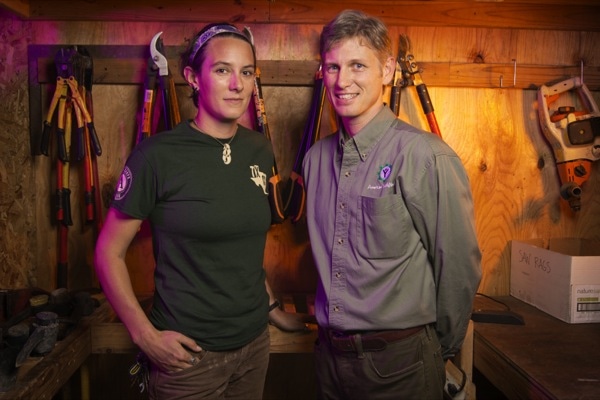
Austin Chronicle: Out in the field, did you find challenges or issues with fly-by-night nonprofit operations? Did you have to contend with organizations like that?
MH: Social media was a nightmare, because people make up things or they hear things and now it’s “official.” We definitely had to do some clean-up, not just with ashes, but with media. We were so lucky to have the county by our side and to have come in with that authority and neutrality that comes with being appointed with a task. When those things occurred, instead of having young AmeriCorps members dealing with the legality of it, we had a great support system through the county and could quickly have them deal with some of those illegitimate people that showed up.
And yes, some people were unwilling to cooperate because it’s their game and only their game, and they don’t see a reason to bring in another nonprofit. The favorite phrase is ‘play nice in the sandbox.”
We were not known in our state at that point. They didn’t know we were a resource. While the situation in Bastrop was huge, Texas was dealing with 23 declared counties at once. At times there were a lot of stumbling blocks with FEMA and the state because they were dealing with 23 counties and we were in one – we ended up in three, but we were in one at the time. Building that relationship with the state and FEMA could be really difficult. We had a hard time in the first couple of weeks establishing that trust and visibility.
Within the CNCS, you have your fully funded NCCC, FEMA Corps, Vista, your big federal programs. There are certain tasks that are allocated to mission assignments – two of them are volunteer and donations management. In the case of Bastrop, two different NCCC teams were called in to support that operation. They were great and capable and worked right alongside us. But the mechanism to get them there is a lot different from ours. They have to be integrated with a community sponsor on the ground, all working together.
Austin Chronicle: So, then what are the differences between the NCCC groups that came in from across the country and your TxCC group? How are the missions different?
PS: Because of our style of operation in the field on other conservation projects, trail building or forestry or chainsaw crews – all the stuff we do the rest of the year, we have some skill sets and ways of operating that make us really good in these chaotic situations. There’s a lot of field-based decision making. We do a lot of our own design work on the conservation projects that we do. We’re responsible for the outcomes of these projects and that means in the field we have to make good decision, often hard decisions, and leave people happy on the other side. And we’re sort of in charge of those projects. Some of the other programs that you mentioned show up and serve as a resource to support. It might be that some entity would call them to build a trail but they would have their own staff to manage. We come in as more of a ready-made unit that knows how to operate independently and say ‘yes or no,’ and make our own decisions and manage our own people in a stronger kind of on the ground way.
We are dependent on creating good relationships that last long-term. Bastrop is our neighbor, but they’re also our home. We bring our crews to Bastrop State Park every year to do trainings and ongoing project work. We’re deeply embedded in the reforestation and recovery efforts there. The county is our friend, and we’ll continue to be partners long-term, and we need those kinds of relationships across the state. Because we’re not fully funded federally, we depend on doing good work, being professional, building relationships that last and come back to keep us operational long-term.
Austin Chronicle: Chris [who’s just entered the conversation], please explain this relationship with Bastrop State Park?
CS: Our relationship with Texas Parks and Wildlife goes back eight years or more, but it had been blossoming as we created a conservation corps that was getting noticed around the state. We did a more rigorous training program – a week that happened out in the field in a camping format – in 2010. We started spending a whole week there to orient and skill-train our members, 60 at a time, on federal chainsaw training.
The park has a big economic impact on the county and the city. That relationship had been going on and that was the case when the fire happened, so our initial response was in the disaster response. But early on, we were looking for a way to plug into the ecological restoration of the county, both in private lands and with the county and Texas Forest Service to make sure the private lands are not contributing to erosion.
The training camp was just one week in duration [January, in Austin], which includes hard and soft skills and general expectations and AmeriCorps orientation, then we go into the field for one more week of training down at Bastrop. Sixty folks in a camp, similar to what a civilian conservation corps might look like: Get up every morning, prepare yourself for the day, everybody has a task, getting breakfast ready for everyone else, that sort of thing. Then a series of skills: chainsaw classes, generally a three-day affair; one day of trail work, etc.
PS: That training period is a really good opportunity for us to get a feel for who the new members are who have come to serve, and how they’re going to function as a team. We get to watch them in the field during that orientation period and challenge them with different tasks. The nice part of it is the partnership with the state park because they have a tremendous amount of back-logged need out there. So because we’re doing this training, and we want to have it be real world training, not on a blackboard, we work in partnership with them to develop the projects we’re going to train on.
CS: Using Megan as an example, who was an AmeriCorps member in 2010: She did 4-5 weeks of crew leader training prior to the training that involves every AmeriCorps member, then this two weeks of training with her AmeriCorps team. So that was probably her introduction to Bastrop State Park. She came in at that point, visited a couple of times on projects throughout the year, and then a year-and-a-half later, a fire happens.
The name change [to Texas Conservation Corps] did mark our focus on disaster response. As we changed our name, our grant with the One Star Foundation came on, which makes us a bigger resource with disaster response.
Austin Chronicle: How has this experience helped create templates for future challenges?
CS: American Youth Works, for a long time, has played very minor roles in disasters, primarily in Texas. But when Katrina and Rita happened, we would send crews with chainsaws. We were those show-up-and-volunteer people that needed some direction. We were trying to work with systems, but we weren’t an important resource, we were just extra people showing up with really good chainsaw skills, some tools, and a lot of enthusiasm. That happened many times – flood mucking out in the valley, things like that.
But Megan went to Joplin with her crew as an AmeriCorps member and worked under the St Louis AmeriCorps program. They have a really powerful unit with a long time in disaster relief. They really set an example for how to be a key resource that was ready to go. Megan and our team were put in charge of 2,000 volunteers a day who would need to be organized, and one AmeriCorps member might be supervising a team of 100 individuals on a cleanup effort in Joplin. Some of it was the volunteer registration, some of the other wonky aspects, data management aspects. There was a lot of hands-on volunteer management – how to work safely in a debris field with people who haven’t had real training and not fall on nails and things. From the relationships we’d developed in Joplin, we came back to Bastrop and served there as a really integrated resource working more deeply with FEMA. We got the people involved from other conservation corps and NCCC and FEMA, Megan and her team helped manage how those guys were operating. They were in charge. They were running the show and helped Bastrop establish grounds for recovery.
After Bastrop happened, we began getting more and more calls, because they [CNCS] realized we were a really powerful resource and that we know how to set up reception centers, we know what’s important and how to follow incident command structure. So the presence of the disaster services unit within the corporation became more integrally involved in a lot of disaster response. FEMA was realizing, these guys have a lot of resource to bring to bear and can be leaders rather than just hands on deck.
MH: The disasters we’ve been involved with: From the top, we have Joplin, Bastrop in 2011, New Mexico wildfires in 2012, Isaac at the end of 2012, Sandy, the West, TX explosion, Oklahoma tornadoes, Eagle Pass flooding, Alaska…
CS: Lots of media has happened nationally around AmeriCorps and Conversation Corps presence in disasters. It’s really grown. FEMA started FEMA Corps program. They do something very different. All the conservation corps get together a couple of times a year in conferences, and we stated realizing that we all play different roles, and if we work together and share best practices, we can strengthen corps presence and help communities in a much deeper way. So we organized ourselves intellectually to share best practices, talk about how to get in and be the best resource we can be. The best practices development and working in conjunction with CNCS has raised the bar for what’s possible with our teams. We’re not just going to come in and pick up trash after a storm, we’re going to be significant role players. It’s a great leadership moment for AmeriCorps volunteers. It’s a tremendous responsibility – there’s great backup, but it’s really an opportunity to practice your leadership skills in those moments.
Now the corporation has raised emergency response to a Tier One priority. They tier their priorities of what they’re going to fund, and disaster services has moved up to the top tier. It’s good for the conservation corps because conservation, environmental work has been a lower tier for quite a few years. There’s a real magic combination of the field work in conservation that’s done, the kinds of teams we build as conservation corps, that fits really well with emergency response and disaster relief. With this higher tiering, we’re able to put more focus on the skills needed for emergency response, and they’ll get conservation skills the rest of the year, but we can put a real focus on how to be a high-quality resource at the time of disaster. That’s something I think Megan and the Texas Conservation Corps are really advancing nationally because they’re showing what’s possible.
MH: As much as I’d love to think Bastrop is what raised the bar nationally, it was Joplin. Most programs went home and thought about how to affect their local community. Minnesota Conservation Corps and Washington Conservation Corp and we are probably the three big ones that have put a lot of focus on training, effort, relationship-building in the emergency response world at home. Joplin was in May 2011; we were there June and July of 2011.
Bastrop happened, and what we really took away from it, and what we are doing to raise the bar locally is building partnerships within the state. We have a great relationship with the Texas Division of Emergency Management and the One Star Foundation, and we are now able to build relationships and train others on volunteer management.
You asked about templates for future challenges, and all I kept thinking was, the biggest thing we took away from this is relationship building and how important it is to know your neighbor and your other organizations and who’s out there. We’ve spent the past year alongside One Star, building those relationships and looking locally on how we affect our own community and how we can help our state in a time of need, which ultimately can help other states. But our focus right now is making Texas the template for volunteer management that other states will look to. How does government look to volunteerism in terms of need? We want to build that template, and having national service is a key part of that plan.
PS: Volunteerism is critical in these situations, but organization around that is necessary. The unaffiliated volunteers that show up can become a burden if not organized and channeled properly. That’s what the Corps have always been good at – getting people organized, aligned, getting them the skills and training to be safe and effective. The things we do year-round play in really well to organizing volunteers to be as effective as possible.
RM: I think we’ve just barely touched on it, but there’s been a lot of work in Bastrop over the last couple of years that has helped to bring it back to being able to open again for visitors, and there have been a lot of groups that played a role in that. We were there for about a year full-time in the state park. Tree Folks and the Ladybird Johnson Wildflower Center played a big role in planting trees and growing seedlings. Texas A&M has been out there a lot volunteering. I think that’s a big part of the two years later story – what’s been going on since then.
MH: Nothing is done alone. That’s the whole point of volunteerism. If you’re a homeowner, watching your life get destroyed, and it’s going to take you a year to clean up all the tiny pieces – when you have a community behind you, when you have relationships and partnerships, it can become a couple months. That’s what’s going on in Bastrop – community engagement, partnerships, people working together.
PS: Outside of the state park, in partnership with the county and forest service, and the Austin Community Foundation for supplying some funds to help the private land areas deal with erosion control problems – every piece of vegetation burned away, every rain takes the soil into the creeks and causes problems. We were working in conjunction with all these partners and the long-term recovery group in Bastrop to coordinate those activities on the private lands and make sure the soils were stabilized. There was some good work that happened outside of the state park as well, and important work for long-term recovery.
Austin Chronicle: Regarding Austin Community Foundation, were you part of the Central Texas Wildfire Fund [for which the concert raised money early on in the disaster]?
PS: We didn’t have any involvement in the concert or garnering of those funds. Austin is really good when there is a need. Like after Katrina or Rita, Austin responded. That’s one of the beautiful things about being here. They got all this resource together [early on in the case of the Bastrop disaster], but there weren’t systems in place to distribute it yet, so the Community Foundation was the best place to put it. Then they began reaching out for how to distribute those funds. They knew we were a resource, and we worked together with that. That worked really well for us.
CS: There were funds available, and we had people on the ground being a conduit for recovery. We put the proposal together based on that. We had county and state park support, and we were a way for those funds to have immediate impact on those resources.
PS: We always serve as hardcore as we can, give the best effort, work extra time off the clock, because that’s the ethic that our people bring to the table. We’re a very economic means of delivering service. We were already working there at the state park, we’re a known entity.
MH: There were a lot of organizations that wanted to do rebuilding and assist survivors, and then here’s this environmental group that gets some funds to put some seeds in the ground. But the reality of the community in Bastrop is that people live out there because of their land. I remember sitting in town hall meetings where people weren’t asking [the typical post-disaster questions, like], ‘How am I getting my I-beam off this property?’ They were asking ‘What do I do about my deer and my wildlife? How do I feed them and get them back?’ That’s the type of community to which we were continually exposed. People applied who needed trees and grasses back on their property. They sought out free assistance to rebuild their ecological system.
Something that’s unique in Texas is that public lands are affected by private lands. If private lands aren’t taken care of after a fire, that affects your public infrastructure and the new house you just built, the economic value, your quality of life. Can your children go play in your backyard with dead standing trees? Probably not.
Addressing those issues, while it may have seemed out of order – I think it did shake out all right. Once local politics calmed down, and the right organizations were able to stand up and apply for funds, the funds trickled in the way they traditionally do after a disaster.
RM: Restoration, replanting, things like that, that prevents future problems down the road. It’s important, and people realized that eventually.
PS: We were a very visible, effective use for a small percentage of those funds.
Austin Chronicle: So you feel it all shook out well.
MH: The biggest thing that’s come out of Bastrop for us is that we partnered with One Star Foundation and the Texas Division of Emergency Management to host 20 Americorps members annually – train, manage, and supervise them for the state of Texas, specifically for volunteer and donations management. This was our first year and we’ve learned a lot.
Overall it’s been a huge success, and it was amazing for me to go down to [the Galveston] conference, because I didn’t meet any of these [other disaster engaged] people until Bastrop. To see the respect our AmeriCorps members now get, and that we are being publicly acknowledged for being compassionate, hardworking people, is really phenomenal to get that opportunity, both for Texans and people outside of our state. And to build those relationships to work off of Bastrop, not just walk away from it, but take some lessons learned, relationships and friendships and be a really strong resource for our state, is awesome.







